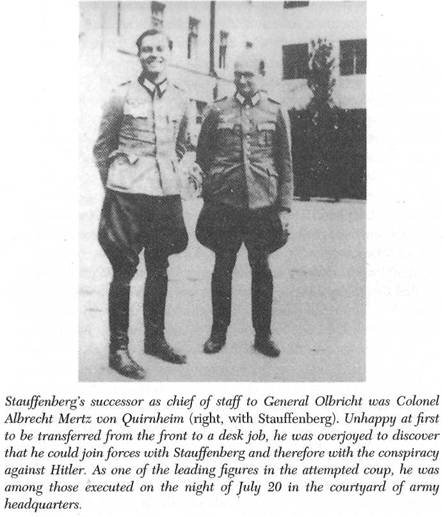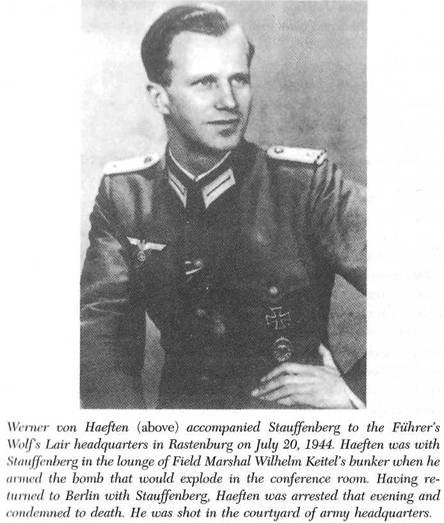measure of humiliation by purging itself of the Nazis. In a subsequent conversation with Beck, Stauffenberg reviewed what had gone wrong on July 15 and pledged that “the next time he would act, come what may.

As always happened when things were heading toward a climax, more bad news arrived-of precisely the kind that had repeatedly sapped the conspirators’ resolve in the past. First, while returning from the front Field Marshal Rommel was severely injured when his car was strafed by an airplane. To be sure, he had never really figured in the plans for a coup, but when he had been asked the previous day how he would react if Hitler rejected his “ultimatum,” he had coolly replied that he would “throw open the western front,” thereby fueling the opposition’s lingering hope of unilaterally putting a stop to the fighting on that front.17 Furthermore, Rommel was extremely popular with the general public, and though he was certainly not an enemy of the regime, the insurgents hoped that he might join them if the circumstances were right. Rommel’s participation would have helped prevent the creation of another stab-in-the-back legend, a concern that had so preoccupied the conspirators.
In the midst of all the other bad news, however, the loss of Rommel was scarcely noticed. Much more disturbing to the conspirators was a tip from Arthur Nebe that Goerdeler had been named by Wilhelm Staehle and was about to be arrested. Stauffenberg responded to the information by asking Goerdeler “to disappear as quickly as possible and not endanger the entire conspiracy by running around Berlin making telephone calls.” Goerdeler, already bitter at having been pushed about for months and feeling increasingly squeezed to the periphery of the conspiracy, took this as another attempt to belittle him, especially since Stauffenberg did not mention that he had been summoned to report to Hitler’s headquarters on July 20, just two days hence. Nevertheless, Stauffenberg did ask Goerdeler to remain ready for a coup, and Goerdeler let it be known that his hiding place over the next few days would the estate of his friend Baron Kraft von Palombini in Rahnisdorf.18
Possibly even more disconcerting was a warning delivered to Stauffenberg on July 18 by Lieutenant Commander Alfred Kranzfelder: a rumor was circulating in Berlin, Kranzfelder reported, that “Fuhrer headquarters would be blown sky-high that very week.” It seems that a young Hungarian nobleman had picked up this piece of information at the Potsdam home of the widow of General von Bredow, one of those murdered in the Rohm putsch. Later it turned out that the source was none other than one of the Bredow daughters, who was on friendly terms with Werner von Haeften, and it was reasonable to conclude that the information had thus far been confined to the Bredow household and had not actually spread to Berlin. But Schulenburg also informed the conspirators that day that “two men had been inquiring about him in his neighborhood” and that he did not think they were harmless visitors.19
These and other tips made Stauffenberg feel even more strongly that he had to act immediately. He felt driven as well-perhaps even more-by his chagrin at the delays and at the lack of resolve over the previous weeks. His exhaustion and his raw nerves, mentioned in various accounts, undoubtedly added to his sense of urgency. One observer spoke, with poetic overtones, of the “dark shadow” that seemed to have enveloped him since June. In any case, as Stauffenberg now said to Kranzfelder, “There’s no choice now; we’ve crossed the Rubicon.”20
The next day, July 19, was spent on preparations. By about noon Olbricht’s and Stauffenberg’s staffs were busy alerting Witzleben, Hoepner, Berlin city commandant Paul von Hase, Colonel Jager, Major Ludwig von Leonrod, and the large number of other officers who had roles to play. In the early evening Stauffenberg called on Quartermaster General Wagner in Zossen, hoping perhaps to straighten out the difference of opinion that had arisen on July 15. At the end of their discussion Wagner arranged for a special airplane to be placed at Stauffenberg’s disposal for the return flight from Rastenburg. After Stauffenberg had taken his leave Wagner informed Stieff of the preparations.
Early on the morning of July 20 Wagner greeted Lieutenant Colonel Bernhard Klamroth by asking, “What are we going to do if the assassination really
First, however, the notion that nothing ever happened as a result of their efforts was about to be shattered. Wagner’s query suggests he suddenly realized that Stauffenberg had brought to the resistance an unwavering determination to carry out the plot. One might wonder, as the historian Peter Hoffmann has, why Stieff, Wagner, Meichssner, Fellgiebel, and other officers who had access to Hitler palmed the assassination attempt off on Stauffenberg, whose physical dexterity was limited and whose absence from Berlin would seriously jeopardize the coup following the assassination. In all likelihood, they hadn’t fully understood that they were now irrevocably implicated, and that if Stauffenberg failed their own ruin was assured as well.
All the conspirators wrestled with their doubts that the coup would be successful. Hofacker said he felt that the chances were very small, as did Schulenburg and Berthold von Stauffenberg. Tresckow stated that the attempt would “very likely go awry,” and Beck expressed similar sentiments. Even Stauffenberg was apparently skeptical and told a young officer in early July that “it was questionable whether it would succeed.” In his next breath he revealed how far he had moved from hopes of achieving any far-reaching aims, a feeling shared and in many cases expressed by his close friends. “But even worse than failure,” Stauffenberg continued, “is to yield to shame and coercion without a struggle.”22 This was Stauffenberg’s only certainty. Everything else that followed would be a “leap in the dark.”23
9. JULY 20, 1944
Stauffenberg flew into the Rastenburg airfield shortly after 10:00 a.m. with Werner von Haeften and Helmuth Stieff, who had boarded the flight in Zossen. He immediately headed for the officers’ mess in Restricted Area II, carrying in his briefcase only the papers he needed for the reports he was expected to give. Haeften, meanwhile, carried the two bombs in his briefcase and accompanied Stieff to OKH headquarters. The plans called for Haeften and Stauffenberg to meet shortly before the briefing in the Wolf’s Lair to exchange briefcases.
At around eleven o’clock Stauffenberg was summoned by the chief of army staff, General Walther Buhle, and after a short meeting they proceeded together to a conference with General Keitel in the OKW bunker in Restricted Area I. Here Stauffenberg learned that on account of a visit by Mussolini what was to have been a noon briefing with Hitler had been put back half an hour to twelve-thirty. Immediately following the conference with Keitel, Stauffenberg asked the general’s aide, Major Ernst John von Freyend, to show him to a room where he could wash up and change his shirt-July 20 was a hot day.
As Keitel and the other officers headed toward the briefing barracks, Stauffenberg met Haeften in the corridor. Together they withdrew into the lounge in Keitel’s bunker, where Stauffenberg set about installing and arming a fuse in the first bomb. He had barely begun, however, when a most unfortunately timed telephone call came from General Fellgiebel, who asked to speak with Stauffenberg on urgent business. Freyend sent Platoon Sergeant Werner Vogel back to the bunker to urge Stauffenberg to hurry.

As Vogel entered the lounge, he saw the two officers stowing something into one of the briefcases. He informed them of the call, adding that the others were waiting for them outside. Meanwhile Freyend shouted from the entrance, “Stauffenberg, please come along!” With Vogel standing in the doorway, Stauffenberg closed the briefcase as swiftly as possible while Haeften swept up the papers that were lying around and stuffed them into the other briefcase.
Fellgiebel’s telephone call and the intrusion of Sergeant Vogel may well have determined the course of history, for it is likely that they prevented Stauffenberg from arming the fuse on the second package of explosives. No one knows for certain why Stauffenberg did not place the second bomb in his briefcase alongside the one whose timer had already been activated, since the explosion of one would surely have set off the other as well.

